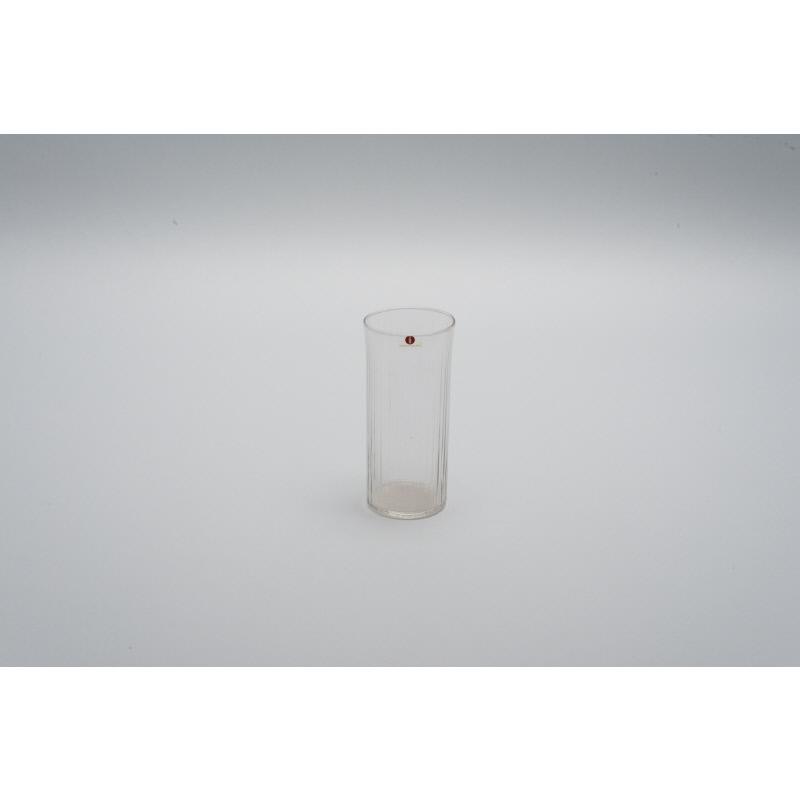Currently indexing
Glass
Classification(s):
Glass
Date: c.1951 - 1976
Organisation: Iittala (Finnish, founded 1881)
Dimensions:
143 × 64 mm (14.3 × 6.4 cm)
Medium: Glass
Object number: G355L
See Also
Place of Production:Finland
DescriptionGlass with vertical ridges, manufactured by Iittala. Made in Finland.
ProvenanceThis object was originally acquired for the Inner London Education Authority’s (ILEA) ‘Circulating Design Scheme’ collection.
The collection was instigated by the London Country Council (later the Greater London Council) and the Council of Industrial Design (COID). The collection’s original purpose was concerned with the teaching and dissemination of modern, ‘good design’.
The collection was established in 1951/52 as the ‘Experiment in Design Appreciation’, later renamed the ‘Circulating Design Scheme’.
The Circulating Design Scheme lent boxed showcases to London schools. The showcases contained handling objects, material samples and interpretation on a specific subject.
COID withdrew its involvement in the Scheme in 1957. After which time, it was managed exclusively by the London County Council from 1957-1963.
After the administrative restructuring of London authorities, the Scheme was jointly managed by the Greater London Council and the Inner London Education Authority (ILEA) from 1963 – 1976.
The Scheme was operational until 1976 when the collections were withdrawn from circulation. ILEA was abolished in the late 1980s and the collection was donated to Camberwell College of Arts in 1989/90.
ILEA was responsible for secondary and tertiary education in the inner London boroughs, this included Camberwell.
The collection was instigated by the London Country Council (later the Greater London Council) and the Council of Industrial Design (COID). The collection’s original purpose was concerned with the teaching and dissemination of modern, ‘good design’.
The collection was established in 1951/52 as the ‘Experiment in Design Appreciation’, later renamed the ‘Circulating Design Scheme’.
The Circulating Design Scheme lent boxed showcases to London schools. The showcases contained handling objects, material samples and interpretation on a specific subject.
COID withdrew its involvement in the Scheme in 1957. After which time, it was managed exclusively by the London County Council from 1957-1963.
After the administrative restructuring of London authorities, the Scheme was jointly managed by the Greater London Council and the Inner London Education Authority (ILEA) from 1963 – 1976.
The Scheme was operational until 1976 when the collections were withdrawn from circulation. ILEA was abolished in the late 1980s and the collection was donated to Camberwell College of Arts in 1989/90.
ILEA was responsible for secondary and tertiary education in the inner London boroughs, this included Camberwell.
NotesThis object was circulated to London schools as part of the Inner London Education Authority’s (I.L.E.A) Circulating Design Scheme, which operated from 1951-1976. The ribbed glass tumbler featured in the ‘Design for Tableware’ group in case number 2. The original supplier from whom this object was acquired is unknown. The photograph does not have an associated record card. Original photograph of boxed showcase copyright Harold King (Photography) Ltd, Morden, Surrey.
Founded in 1881 in a village of the same name in Finland, Iittala was one of the first companies to transition from making decorative dinner sets to functional aesthetically pleasing objects in line with progressive Scandinavian design. In the 1930s and 1940s, designers like Kaj Franck led the development of the Iittala brand. With a modernist and functionalist agenda, the company designed and produced products which were beautiful and functional, and that were available to everyone. This had an impact on glassware ranges; simplified, modern design took over from cut crystal.
Founded in 1881 in a village of the same name in Finland, Iittala was one of the first companies to transition from making decorative dinner sets to functional aesthetically pleasing objects in line with progressive Scandinavian design. In the 1930s and 1940s, designers like Kaj Franck led the development of the Iittala brand. With a modernist and functionalist agenda, the company designed and produced products which were beautiful and functional, and that were available to everyone. This had an impact on glassware ranges; simplified, modern design took over from cut crystal.








